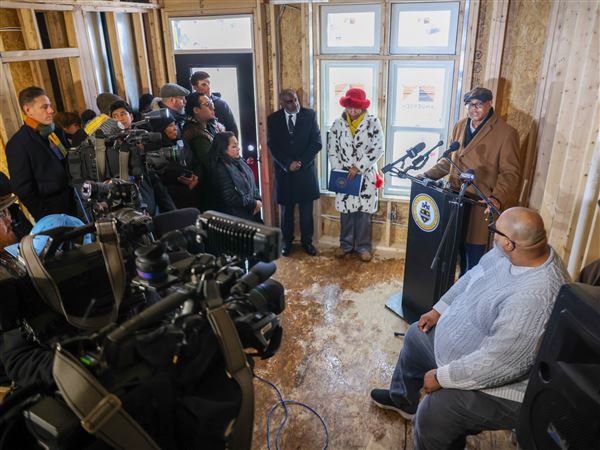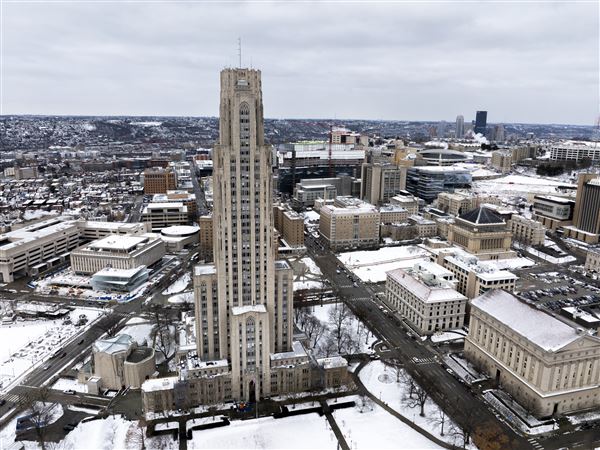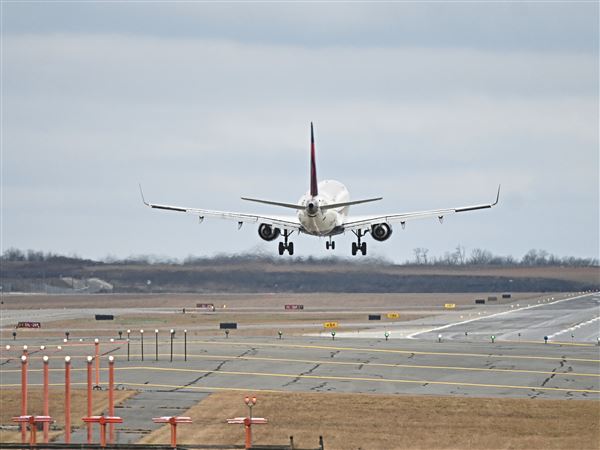A robotic cart carrying oversized ceremonial scissors drove itself up to the stage where a gaggle of company executives waited. As they snipped the ribbon strung up, confetti shot off and electronic music throbbed through the warehouse.
Meanwhile, a trade show-style display was laid out in the next room featuring 3-D printers, portable machines and a self-driving vehicle from Pittsburgh-based Seegrid cruising around, programmed to search for inventory that it could grab and move.
The jazzing up of the ribbon-cutting event — often dry, corporate affairs — offered a pretty good microcosm of the company behind this new $32 million facility in East Huntingdon.
Siemens — a 170-year-old German conglomerate and Europe's largest industrial manufacturing company — has been leaning more on the Pittsburgh region to help it shift focus from mainly making big things to also developing the software and technology that connects, controls and services those things more efficiently.
At the 300,000-square-foot facility spanning a section of the former Sony plant in the RIDC Westmoreland industrial park, about 150 Siemens Energy workers will repair and maintain generators and turbines for electric power plants all over the world.
The new Pittsburgh Service Center consolidates work previously performed at older, less organized facilities in New Kensington and Monroeville, Siemens officials said.
While no new jobs were announced, company officials said the investment — combined with a new apprenticeship program for machining and welding students at Westmoreland County Community College — allows the company to grow.
Siemens has been making moves elsewhere in the region, as well.
In Munhall and East Pittsburgh, its mobility business employs 238 engineers and product designers to develop software systems meant to prevent deadly train accidents. Known as positive train control, the autonomous safety systems are required by Congress for passenger and large freight trains — but Siemens has an eye toward helping railroads gather data to move trains more efficiently.
In New Kensington, about 400 people work to develop air-cooled and water-cooled industrial drive technology used around the world. A subset of that facility is dedicated to engineering what is fantastically called the “MindSphere,” a cloud computing platform that will help manufacturers operate more efficiently.
In total, Siemens employs about 1,250 people across eight locations in the region. The company’s footprint includes digital applications, building technologies, mobility and power generation services.
A different focus
The growth in Pittsburgh comes as some investors have pushed Siemens — and its American competitor, General Electric — to reorganize their sprawling businesses as global demand has slowed for power equipment and other manufactured goods.
Both companies play in similarly varied markets — from health care to renewable energy to transportation — and both got a little too big for investors’ liking. As of last year, Siemens had around 377,000 employees in more than 200 countries; General Electric had 313,000 employees in 180 countries.
In 2014, Siemens’ German executives launched Vision 2020, an overhaul to streamline its businesses, slash costs and sell off underperforming businesses. Siemens is combining five industrial businesses into three categories focused on power turbines and gas; manufacturing software and automation; and infrastructure.
The plan seems to be putting the company in better shape. Earlier this month, Siemens reported full-year earnings of $6.9 billion and increased its dividend to investors.
Siemens has been outperforming its rival this year.
General Electric, which employs about 2,000 in Western Pennsylvania, has also been working to sell off business segments as its stock price has tumbled by about 54 percent through 2018 — compared with Siemens’ 18 percent decline over the same period.
And Siemens and General Electric will see their engineering work collide southeast of Pittsburgh.
Clash of the conglomerates
In May, General Electric agreed to sell its locomotive manufacturing business, GE Transportation, to Wabtec Corp. The proposed merger is expected to make Wabtec, a nearly 150-year-old rail products manufacturer based in Wilmerding, into a Fortune 500 company.
The $11 billion deal would also put the former General Electric business within five miles of the Siemens’ rail automation facilities.
For Siemens, it’s no coincidence the companies have met in Pittsburgh. The region has proven internationally competitive with access to skilled workers coming out of the University of Pittsburgh and Carnegie Mellon University and the rise of advanced manufacturing.
While Siemens invests in tech startups in Silicon Valley, Pittsburgh is where many of the ideas are borne out.
“What’s going on in Pittsburgh is really the ideal picture of what’s going on across the U.S. in manufacturing,” said Barbara Humpton, CEO of Siemens USA, in an interview this month.
“People are taking the know-how in the physical world and they’re bringing in the skills in what’s to come in the digital world. It’s creating — and I don’t think this is an overstatement — it’s creating brand new markets.
“This is where we’ve been putting all our efforts,” she said.
Siemens, coinciding with Ms. Humpton’s visit to speak at a tech event, tweeted a video called “Siemens & Pittsburgh: Creating a Technology Powerhouse Together.” In between shots of Downtown and old footage of steel mills, Siemens employees showed off the facilities.
#AtlanticForgingAhead reminds us that #Pittsburgh is combining manufacturing with software to build a new digital economy. Steel City is reinventing itself into a “technology powerhouse.” pic.twitter.com/jwC37XEKCK
— SiemensUSA (@SiemensUSA) October 16, 2018
Siemens' foray into digital technology in the region hasn't been without challenge.
Wabtec, which worked alongside Siemens to build positive train control systems for freight rail company CSX Corp., has accused Siemens of using its confidential trade secrets to develop a competing product. Wabtec claims in a lawsuit that Siemens shares a workspace at CSX facility in Jacksonville, Fla., and had access to test scripts.
The legal challenge, filed in 2016, is ongoing. Spokespeople for Wabtec and Siemens said their companies don’t comment on litigation.
Wabtec’s purchase of GE Transportation will likely heighten the competition. Wabtec executives said earlier this year they see opportunities in autonomous technology in the rail industry.
Siemens’ Munhall facility has grown from about 50 people six years ago to 238 employees today, said John Paljug, head of the Siemens Rail Automation business. That plant, among other things, makes computer systems for commuter rail systems in New York and Boston that garner location and speed data from every train in real time.
Those systems, Mr. Paljug said, allow operators to move trains closer together because they can ensure they won’t collide. The New York City Transit Authority, using Siemens’ systems, can run 26 trains an hour — up from 16 to 18 trains an hour.
“You have information you didn’t have in the past,” Mr. Paljug said. “All of a sudden, we know where trains are to a higher granularity given that we’re using GPS. You can see where the technology could go with something like this.”
Daniel Moore: dmoore@post-gazette.com, 412-263-2743 and Twitter @PGdanielmoore
First Published: November 20, 2018, 2:00 p.m.




















